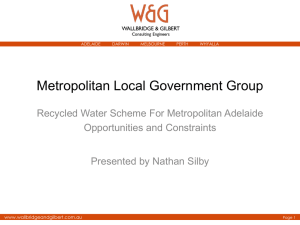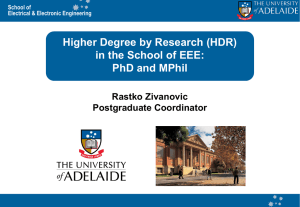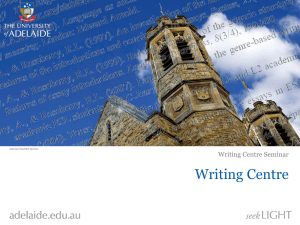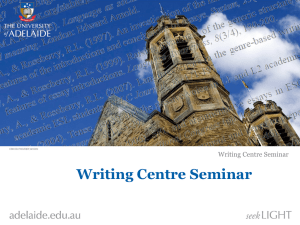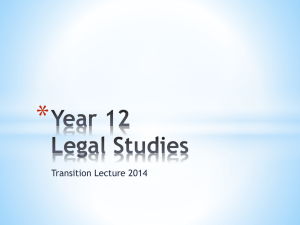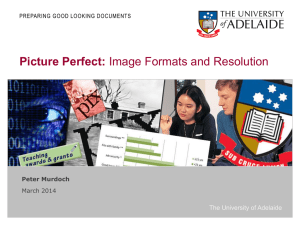Evaluation of the 30-Year Plan for Greater Adelaide
advertisement
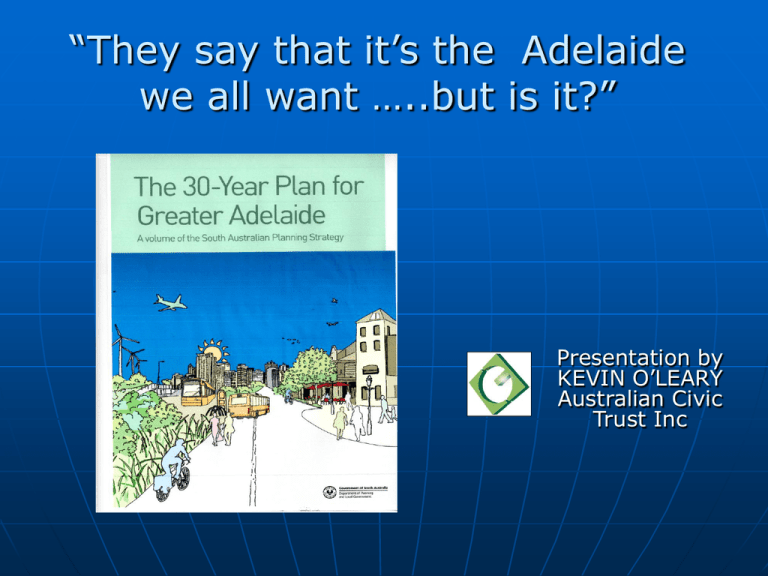
“They say that it’s the Adelaide we all want …..but is it?” Presentation by KEVIN O’LEARY Australian Civic Trust Inc The Adelaide planning process: Draft report on the 30 - year plan: ‘Planning the Adelaide we all want’ Final Report on the 30 - year plan ‘It is imperative that the community supports the plan if its policy objectives and housing and employment targets are to be met’ Planning and Development Steering Review Committee Report p65 ‘The State Government must begin the process (of reform) by articulating a broad set of directions. While a bottom up process may seem desirable, there are such critical issues, and in some cases such limited choices, that the State Government must set a broad vision and direction in the first instance.’ Oregon Processes: New Civic Trust charter Encourage wider cross section of community involvement New approaches to entice public interest Involve public in all phases of planning process Ensure range of options analyzed Proper research and analysis required Appropriate responses to submissions Separate Government consultation unit Emphasis on ‘participation’ not just consultation No special privileges to key stakeholders Backed with appropriate legislation Flaws with the 30 Year Plan Ineffective measures to contain urban sprawl Poor research and analysis Poorly worked through assumptions in the determination of future population levels No overarching vision for transport Inappropriate densification proposals along major arterial roads 1. Ineffective measures to contain urban sprawl Urban growth boundary abandoned Prime agricultural land being lost Housing Affordability Aust. concedes Adelaide plan is not appropriate Peak oil will make living in fringe areas untenable (Aust. Planning Institute) 2. Poor analysis of the future spatial organization of the city Melbourne has examined future spatial organizational options: Super CBD Growth in Activity Centres only Polycentric city: middle centres Polycentric city: outer centres Inner city in public transport rich areas Adelaide plan at odds with Melbourne analysis Limitations even with Melbourne study Source: ‘Macro Urban Form’ Victorian Department of Transport 3. Poorly worked through assumptions in the determination of future population levels Independence of govt. population committee questionable Rann govt. should have waited for Federal Government’s report on a ‘Smaller Australia’ Inner Rim Structure Plan highlights questionable population projections 4. The lack of an overarching vision for transport Adelaide is the only capital city in Aust. that doesn’t have a transport plan Alternative transport options not analyzed There are major omissions in transport Govt’s transport strategy • Lack of attention to travel demand management strategies • Inadequate program for delivering transit-oriented development • Poorly developed strategies for commuter travel 5. Inappropriate densification proposals along major arterial roads Proposal emanates from a report prepared by Rob Adams in Melbourne on Transforming Australian Cities but with some major differences Rob Adams report doesn’t deal with adverse health effects ‘Planned community’ response from Premiers Dept not satisfactory Experience in Curitiba not relevant to Australian cities Perth has a more appropriate strategy Not desirable to match employment and housing in each neighborhood Serious implications for industry Impacts of high trafficked areas on public health In 2010 the US Health Effects Institute undertook the largest international study ever launched on vehicle air pollution and health. It examined 700 worldwide health-pollution studies and concluded that within 300 – 500 metres of heavily trafficked roads the resultant pollution: Exacerbated asthma in children Triggered asthma cases across all ages Impaired lung function in adults Caused cardiovascular disease and death Other studies in the US have shown that pollution from high trafficked areas has also caused : Pregnant women to be more likely to have premature and low weight babies Children to develop all types of cancers including leukemia Shorter life spans for nearby residents Residential densification along main roads strategies in 3 cities compared Adelaide 30 Year Plan Curitiba, Brazil Perth, WA No. of corridors selected Large number selected many of which are inappropriate for residential densification Higher density development restricted to 5 road arteries Only Activity Corridors selected. Other main roads -Transit Corridors- will be used for moving large volumes of traffic % commuter trips by public transport By 2018 the no. of trips made by public trans. will be only 10 % of the total transport use Currently 75 % of all commuter trips are made by public transport Currently 11 % of all commuter trips are made by public transport Through traffic Not considered Trinary road system addresses problems Through traffic redirected to ‘transit’ corridors Public health issues * Major issue affecting large no’s of people Minor issue Minor issue Freight Unknown movements Residential densities will be increased on primary freight routes Increases in residential density along primary freight routes prohibited Capacity for fast/ high vol. public trans. Low to moderate capacity because of difficulties in developing dedicated rights of way High capacity because of trinary road system Low to moderate capacity *Higher incidences of childhood leukemia, cardiovascular diseases and other serious illnesses are associated with residential development located within 200-300 metres of high trafficked areas.) Curitiba: High rise development along a dedicated bus way Trinary Road System - The centre road has dedicated lanes for bi -articulated buses and on either side of the bus lanes are roadways for local traffic. Parallel to this street are the ‘Rapidas‘: one-way streets providing access to the downtown (Speedy Streets). Rapidas (Speedy Street) - This street is one of the side streets that complement the Trinary Road System by providing an alternative for travelling across the city. Residential densification along main roads - three cities compared Adelaide appears to be moving towards the Curitiba model However, it is most unlikely that it will ever be able to match the high proportion of commuter trips (75%) made by public transport – a critical factor in the success of this model. It’s more likely to reach a level of between 10-20% of commuter trips made by public transport It would be more appropriate that it follow the Perth model where increased residential densities are confined to Activity Corridors. If Adelaide continues to implement provisions in the 30 Year Plan there will be some very grave consequences for public health and traffic congestion Conclusions – 30 Year Plan UGB should be reinstated Population projections should be reviewed when smaller Australia report released A lower target should be set for the amount of fringe development allowed and targets for urban growth should be more regularly reviewed The proposal to densify residential development along major arterial roads should be dropped Locations for the densification of development should be subject to more thorough research and analysis A transport plan should be prepared for Adelaide The Transit /Activity corridors plan for Perth should be given serious consideration here Public consultation processes have to be improved (refer to Civic Trust model)





